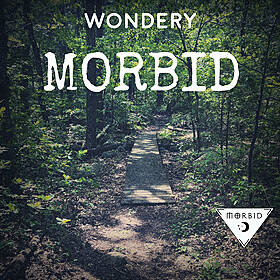
Episode 481: The Murder of Jennifer Corbin- Part 1
31 July 2023 - 58 mins explicitWhen Gwinnett County sheriff’s officers responded to a call about a shooting at the home of Dr. Barton Corbin on the morning of December 4, 2004, they discovered the body of the doctor’s wife, Jennifer Corbin, dead from what appeared to be a self-inflicted gunshot wound. Within a few days, however, investigators learned some things about Bart Corbin that led them to believe that the thirty-three-year-old mother of two may not have taken her own life.
Thank you so much to David White for research assistance :)
References:
Atlanta Journal Constitution. 2006. "Timeline of events in Barton Corbin's case." The Atlanta Journal Constitution, September 17.
Bentley, Rosalind. 2004. "Corbin arres...

Episode 665: Robert Chambers: The Preppy Killer
explicitOn the morning of August 26, 1986, a cyclist in New York’s Central Park discovered the body eighteen-year-old Jennifer Levin. Among other things, Levin had been strangled, there were superficial injuries on her face, and her shirt was pulled up. Later, the medical examiner reported that Jennifer had died only about an hour before she was discovered. It didn’t take long for investigators to find Levin’s assailant, after several patrons at a nearby bar reported seeing her with a man the night before. That man turned out to be nineteen-year-old Robert Chambers Jr., a privileged members of New York’s Upper East Side high society. At first, Chambers denied having anything to do with the murder, but soon changed his story and claimed Levin had died during consensual “rough sex” initiated by Levin herself. Nicknamed the “The Preppy Killer” by the press, a reference to his good looks and obvious privilege, Chambers’ trial became a media circus. Over the course of more than a year, people around the country watched as the defense tried—and with the help of the press, succeeded—to put the responsibility for Levin’s murder on the victim, emphasizing her sexual history and manner of dress, among other things. Thank you to the Incredible Dave White of Bring Me the Axe Podcast for research and Writing support! References Associated Press. 1994. "Central park killer is denied parole again." New York Times, December 23: B4. —. 1997. "Chambers says he is a 'political pawn'." New York Times, Janaury 10: 28. —. 2003. "In statement, Chambers says he regrets his actions." New York Times, February 14: B3. —. 1996. "Parole again denied in '86 killing in park." New York Times, December 17: B2. Freedman, Samuel. 1986. "Darkness beneath the glitter: life of suspect in park slaying." New York Times, August 28: 1. Fried, Joseph. 1986. "Chambers gives not guilty plea in park slaying." New York Times, September 23: B2. Hevesi, Dennis. 1988. "Grandfather faults tactics in park trial." New York Times, March 27: 32. Johnson, Kirk. 1988. "Chambers case turning on truth of confession." New York Times, Janaury 18: B3. —. 1988. "Chambers, with jury at impasse, admits 1st degree manslaughter." New York Times, March 26: 1. Nix, Crystal. 1986. "Slain woman found in park; suspect seized." New York Times, August 27: B1. Raab, Selwyn. 1986. "Lawyer weighs plea of insanity in park slaying." New York Times, August 30: 29. Rimer, Sara. 1986. "Slaying's notoriety touches young crowd on 'the circuit'." New York Times, August 29: 1. Stone, Michael. 1986. "East side story." New York Magazine, November 10. Sullivan, Ronald. 1988. "Chambers gets 5 to 15 years and offers apology in court." New York Times, April 16: 33. Taubman, Bryna. 1988. The Preppy Murder Trial. New York, NY: St. Martin's Press. Today Show. 2016. "Dubbed by the press as 'The Preppy Killer,' Robert Chambers pleaded guilty." Today Show, 01 01. Worth, Robert. 2003. "Robert Chambers to be freed after serving maximumu in 1986 killing." New York Times, February 13: B3. See Privacy Policy at https://art19.com/privacy and California Privacy Notice at https://art19.com/privacy#do-not-sell-my-info.
1 hour 20 mins
21 April Finished

Episode 664: David Carpenter: The Trailside Killer (Part 2)
explicitThroughout the 1960s and 70s, from Los Angeles to San Francisco, Californians were terrorized by multiple killers including notorious serial killers like the Zodiac Killer, the Hillside Stranglers, Herbert Mullin, and Ed Kemper. While the decade may have ended with these killers disappearing or apprehended, the threat of violence and murder simply moved north. Though less known than his contemporaries, David Carpenter was no less prolific and frightening a killer than those men mentioned above. Nicknamed “The Trailside Killer” by the press, Carpenter terrorized Point Reyes and Santa Cruz County for a decade, assaulting, kidnapping, and killing at least eight people, but he was suspected of more. Like those other killers, Carpenter had a long history of violent and antisocial behavior going back to his childhood, including multiple arrests and incarcerations. How was it that a man with such an alarming history of violence could go uncaught for a decade? Thank you to the Incredible Dave White of Bring Me the Axe Podcast for research and Writing support! References Associated Press. 1980. "Trail Killer will strike again." Santa Cruz Sentinel, December 1: 1. Burkhardt, Bill. 1979. "Woman found murdered on Mt. Tam." San Francisco Examiner, August 21: 1. Graysmith, Robert. 1990. The Sleeping Lady: The Trailside Murders Above the Golden Gate. New York, NY: Onyx. Keraghosian, Greg. 2020. "'Do not hike alone': For 21 months, the Trailside Killer terrorized Bay Area's outdoors." San Francisco Chronicle, October 25. Leader, Lewis. 1980. "Identification ends dad's long quest." San Francisco Examiner, December 2: 2. San Francisco Examiner. 1960. "MP's shots foil attack on woman." San Francisco Examiner, July 13: 1. —. 1961. "Presidio attacker gets 14 yrs." San Francisco Examiner, March 10: 11. —. 1960. "Sex case insanity plea." San Francisco Examiner, October 8: 5. Santa Cruz Sentinel. 1970. "Boulder Creek girl attacked." Santa Cruz Sentinel, January 29: 22. —. 1970. "Grand jury indicts con." Santa Cruz Sentinel, July 17: 7. —. 1970. "SLV kidnap suspect flees Calaveras jail." Santa Cruz Sentinel, April 27: 1. The People v. Carpenter. 1997. S004654 (Superior Court of Los Angeles County, April 28). The People vs. David Carpenter. 1999. S006547 (Superior Court of San Diego County, November 29). Todd, John. 1980. "Tam closed in hunt for clues." San Francisco Examiner, October 16: 1. See Privacy Policy at https://art19.com/privacy and California Privacy Notice at https://art19.com/privacy#do-not-sell-my-info.
49 mins
17 April Finished

Episode 663: David Carpenter: The Trailside Killer (Part 1)
explicitThroughout the 1960s and 70s, from Los Angeles to San Francisco, Californians were terrorized by multiple killers including notorious serial killers like the Zodiac Killer, the Hillside Stranglers, Herbert Mullin, and Ed Kemper. While the decade may have ended with these killers disappearing or apprehended, the threat of violence and murder simply moved north. Though less known than his contemporaries, David Carpenter was no less prolific and frightening a killer than those men mentioned above. Nicknamed “The Trailside Killer” by the press, Carpenter terrorized Point Reyes and Santa Cruz County for a decade, assaulting, kidnapping, and killing at least eight people, but he was suspected of more. Like those other killers, Carpenter had a long history of violent and antisocial behavior going back to his childhood, including multiple arrests and incarcerations. How was it that a man with such an alarming history of violence could go uncaught for a decade? Thank you to the Incredible Dave White of Bring Me the Axe Podcast for research and Writing support! References Associated Press. 1980. "Trail Killer will strike again." Santa Cruz Sentinel, December 1: 1. Burkhardt, Bill. 1979. "Woman found murdered on Mt. Tam." San Francisco Examiner, August 21: 1. Graysmith, Robert. 1990. The Sleeping Lady: The Trailside Murders Above the Golden Gate. New York, NY: Onyx. Keraghosian, Greg. 2020. "'Do not hike alone': For 21 months, the Trailside Killer terrorized Bay Area's outdoors." San Francisco Chronicle, October 25. Leader, Lewis. 1980. "Identification ends dad's long quest." San Francisco Examiner, December 2: 2. San Francisco Examiner. 1960. "MP's shots foil attack on woman." San Francisco Examiner, July 13: 1. —. 1961. "Presidio attacker gets 14 yrs." San Francisco Examiner, March 10: 11. —. 1960. "Sex case insanity plea." San Francisco Examiner, October 8: 5. Santa Cruz Sentinel. 1970. "Boulder Creek girl attacked." Santa Cruz Sentinel, January 29: 22. —. 1970. "Grand jury indicts con." Santa Cruz Sentinel, July 17: 7. —. 1970. "SLV kidnap suspect flees Calaveras jail." Santa Cruz Sentinel, April 27: 1. The People v. Carpenter. 1997. S004654 (Superior Court of Los Angeles County, April 28). The People vs. David Carpenter. 1999. S006547 (Superior Court of San Diego County, November 29). Todd, John. 1980. "Tam closed in hunt for clues." San Francisco Examiner, October 16: 1. See Privacy Policy at https://art19.com/privacy and California Privacy Notice at https://art19.com/privacy#do-not-sell-my-info.
1 hour 7 mins
14 April Finished

Episode 662: The Exorcism of Roland Doe
explicitIn the winter of 1973, director William Friedkin released his iconic horror classic The Exorcist, a film that has shocked and terrified audiences for more than fifty years. Based on William Peter Blatty’s novel of the same name, The Exorcist tells the story of a young girl who becomes possessed by a demonic entity, and the two Catholic priests who attempt to exorcise the demon. Even more terrifying than the content of the film, however, was the fact that The Exorcist was supposedly based on a true story. William Peter Blatty had always stated The Exorcist was based on a supposedly true story he’d heard while at Georgetown University. According to Blatty, a Maryland boy, known as “Roland Doe,” had become possessed by a demonic entity and, among other things, underwent a negative personality change and began exhibiting impossible abilities including an ability to speak Latin. It was only through the dedication of one Jesuit priest that the boy was eventually freed of his possession and went on to live a normal life. Since the release of both the novel and the film in the 1970s, a great deal more has been learned about “Roland Doe” and the supposedly true story that inspired The Exorcist, raising many questions about the veracity of the original claims. Who was “Roland Doe,” and was he truly possessed by a demon, or just the intense emotions of an adolescent boy? Thank you to the Incredible Dave White of Bring Me the Axe Podcast for research and Writing support! References Allen, Thomas. 1993. Possessed: The True Story of the Most Famous Exorcism of Modern Time. New York, NY: Doubleday. Associated Press. 1949. "'Evil spirit' cast out of 14-yearf-old." The Bee (Danville, Virginia), August 10: 8. McGuire, John M. 2005. "Priest was last of three who did 1949 exorcism." St. Louis Post-Dispatch, March 3: A1. News and Observer. 1964. "Tar Heel develops space ceramics." News and Observer (Raleigh, NC), September 3: 27. Nickell, Joe. 2001. "Exorcism!: Driving Out the Nonsense." Skeptical Inquirer 20-24. Opsasnick, Mark. 1999. "The haunted boy of Cottage City, the cold hard facts behind the story that Inspired The Exorcist." Strange Magazine. Young, Maya. 2010. Boy whose case inspired The Exorcist is named by US magazine. December 20. Accessed March 17, 2025. https://www.theguardian.com/us-news/2021/dec/20/the-exorcist-boy-named-magazine. See Privacy Policy at https://art19.com/privacy and California Privacy Notice at https://art19.com/privacy#do-not-sell-my-info.
1 hour 9 mins
10 April Finished

Episode 661: Herbert Mullin: The Killer Hippie (Part 2)
explicitThroughout the early 1970s, California’s Bay Area was in the grip of terror as multiple serial killers operated at the time same time and in more or less the same space. In time, some of these killers, like Ed Kemper, would be caught, while others, like the Zodiac Killer, would remain unidentified. Yet it was the ones who appeared to kill at random, without any preferred victim, that would prove the most terrifying and most difficult to catch. Herbert Mullin was one such killer, and while he may have been active for a very short period, he managed to do a tremendous amount of damage in such a little amount of time. Over a five-month period in late 1972 and early 1973, Herbert Mullin killed thirteen people, including a college girl, a Catholic priest, and a former high school friend and that friend’s neighbors. To investigators, Mullin’s victims appeared to be—and indeed largely were—chosen at random and the weapons used were chosen more out of convenience than pathology. Had Mullin’s final murder not been committed in full view of witnesses, there’s a very good chance he would have gone on to kill many more people before being caught, if he ever was. Thank you to the Incredible Dave White of Bring Me the Axe Podcast for research and Writing support! References Associated Press. 1972. "Dragnet set up for Catholic priest's slayer." Los Angeles Times, November 4: 34. Dowd, Katie. 2022. "'Murder capital of the world': The terrifying years when multiple serial killers stalked Santa Cruz." SF Gate, August 21. Green, Ryan. 2024. I Hear Voices: A Descent into the Dark Half of Psychotic Killer, Herbert Mullin. Herefordshire, UK: Independent. Honig, Tom. 1973. "Did Mullin slay fourteen." Santa Cruz Sentinel, August 10: 1. —. 1973. "Mullin enters plea: innocent, insanity." Santa Cruz Sentinel, June 13: 1. —. 1973. "Mullin explains his reason for killing." Santa Cruz Sentinel, August 15: 1. —. 1973. "Mullin is found guilty." Santa Cruz Sentinel, August 20: 1. —. 1973. "'Overtones' of drugs in five slayings." Santa Cruz Sentinel, January 28: 1. —. 1973. "Slaying suspect called a 'quiet, regular guy'." Santa Cruz Sentinel, February 15: 1. Lunde, Donald, and Jefferson Morgan. 1980. The Die Song: A Journey into the Mind of a Mass Murderer. New York, NY: Norton. Santa Crus Sentinel. 1973. "Suspect charged in six shootings." Santa Cruz Sentinel, February 15: 1. Santa Cruz Sentinel. 1972. "Another disturbance at SC County Jail." Santa Cruz Sentinel, September 14: 19. —. 1972. "Body of slain transient is identified." Santa Cruz Sentinel, October 16: 10. —. 1972. "Investigator hired to find Cabrillo coed." Santa Cruz Sentinel, November 26: 46. —. 1972. "Priest slain in confessional box of church." Santa Cruz Sentinel, November 3: 2. Smith, Dave. 1973. "Killer of killers? Town waiting for answer." Los Angeles Times, February 19: 3. United Press International. 1973. "Friends claim man charged with 7 deaths used drugs." Sacramento Bee, February 16: 21. See Privacy Policy at https://art19.com/privacy and California Privacy Notice at https://art19.com/privacy#do-not-sell-my-info.
54 mins
7 April Finished

Episode 660: Herbert Mullin: The Killer Hippie (Part 1)
explicitThroughout the early 1970s, California’s Bay Area was in the grip of terror as multiple serial killers operated at the time same time and in more or less the same space. In time, some of these killers, like Ed Kemper, would be caught, while others, like the Zodiac Killer, would remain unidentified. Yet it was the ones who appeared to kill at random, without any preferred victim, that would prove the most terrifying and most difficult to catch. Herbert Mullin was one such killer, and while he may have been active for a very short period, he managed to do a tremendous amount of damage in such a little amount of time. Over a five-month period in late 1972 and early 1973, Herbert Mullin killed thirteen people, including a college girl, a Catholic priest, and a former high school friend and that friend’s neighbors. To investigators, Mullin’s victims appeared to be—and indeed largely were—chosen at random and the weapons used were chosen more out of convenience than pathology. Had Mullin’s final murder not been committed in full view of witnesses, there’s a very good chance he would have gone on to kill many more people before being caught, if he ever was. Thank you to the Incredible Dave White of Bring Me the Axe Podcast for research and Writing support! References Associated Press. 1972. "Dragnet set up for Catholic priest's slayer." Los Angeles Times, November 4: 34. Dowd, Katie. 2022. "'Murder capital of the world': The terrifying years when multiple serial killers stalked Santa Cruz." SF Gate, August 21. Green, Ryan. 2024. I Hear Voices: A Descent into the Dark Half of Psychotic Killer, Herbert Mullin. Herefordshire, UK: Independent. Honig, Tom. 1973. "Did Mullin slay fourteen." Santa Cruz Sentinel, August 10: 1. —. 1973. "Mullin enters plea: innocent, insanity." Santa Cruz Sentinel, June 13: 1. —. 1973. "Mullin explains his reason for killing." Santa Cruz Sentinel, August 15: 1. —. 1973. "Mullin is found guilty." Santa Cruz Sentinel, August 20: 1. —. 1973. "'Overtones' of drugs in five slayings." Santa Cruz Sentinel, January 28: 1. —. 1973. "Slaying suspect called a 'quiet, regular guy'." Santa Cruz Sentinel, February 15: 1. Lunde, Donald, and Jefferson Morgan. 1980. The Die Song: A Journey into the Mind of a Mass Murderer. New York, NY: Norton. Santa Crus Sentinel. 1973. "Suspect charged in six shootings." Santa Cruz Sentinel, February 15: 1. Santa Cruz Sentinel. 1972. "Another disturbance at SC County Jail." Santa Cruz Sentinel, September 14: 19. —. 1972. "Body of slain transient is identified." Santa Cruz Sentinel, October 16: 10. —. 1972. "Investigator hired to find Cabrillo coed." Santa Cruz Sentinel, November 26: 46. —. 1972. "Priest slain in confessional box of church." Santa Cruz Sentinel, November 3: 2. Smith, Dave. 1973. "Killer of killers? Town waiting for answer." Los Angeles Times, February 19: 3. United Press International. 1973. "Friends claim man charged with 7 deaths used drugs." Sacramento Bee, February 16: 21. See Privacy Policy at https://art19.com/privacy and California Privacy Notice at https://art19.com/privacy#do-not-sell-my-info.
1 hour 2 mins
3 April Finished





















